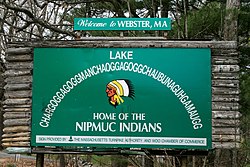You can help expand this article with text translated from the corresponding article in French. (February 2025)Click [show] for important translation instructions.
|
| Loup | |
|---|---|
| Nipmuck | |
| Pronunciation | [lu] loo |
| Native to | United States |
| Region | Massachusetts, Connecticut |
| Ethnicity | Nipmuck |
| Extinct | 18th century |
| transcribed with Latin script | |
| Language codes | |
| ISO 639-3 | Either: xlo – Loup A xlb – Loup B |
xlo Loup A | |
xlb Loup B | |
| Glottolog | loup1243 Nipmuck loup1245 Loup B |
Loup is a term which refers to the Algonquian language varieties spoken in colonial New England as attested in the manuscripts of mid-eighteenth century French missionaries. [1] It was attested in a notebook titled Mots loups (literally translating to 'wolf words'), compiled by Jean-Claude Mathevet, a priest who worked among Algonquian peoples, composing of 124 pages. [2] Loup ('Wolf') was a French colonial ethnographic term, and usage was inconsistent. In modern literature, Loup A refers to the varieties described by Mathevet, and Loup B refers to those described by François-Auguste Magon de Terlaye. [1]
